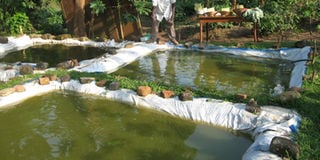Prime
He earns Shs120m from fish a year

Mitusera Bainomugisha feeds fish in one of the ponds. Below: He supervises workers during harvests. Photos By Otushabire Tibyangye.
What you need to know:
He has been involved in commercial fish farming for more than three decades. He tells Otushabire Tibyangye how he started, what he has learned along the way and the challenges.
I am Mitusera Bainomugisha from Iryango village in Kabuyanda Sub county in Isingiro District. I started fish farming in 1983 with three ponds after realising that that there was scarcity of fish in the area. So, I bought tilapia fingerings from Kajjansi fish centre in Kampala.
My intention was to have enough fish for my family and sell the surplus to my neighbours. As time went on I realised that demand was very high and I could not satisfy the market and then decided to venture into commercial fish farming.
Setting up
I started adding on ponds up to the current 30 and I diversified from tilapia to others like milacap and catfish locally known as emale. My venture has since grown into a multi-million business.
A pond stocked with 10,000 catfish yields Shs100m per harvest. Each fish goes for Shs10,000 to Shs150,000 depending on the size. The size of the farm is currently sitting on three hectares with the capacity to expand to about 100 ponds from 30.
About six years ago, I was advised by Dr Justus Rutaitsire from Kajjansi fish centre to merge the small ponds and turn them into commercial ponds, which can accommodate about 10,000 fish fingerings.
My investment plan is estimated at about Shs3b and is able to create about 500 jobs both for technical and casual labourers. The plan includes a hatchery, fish feeds factory and cold storage stores.
Currently, I employ 12 permanent workers and 50 casual labourers, especially during the harvest time. I still have a small labour force because out of 30 ponds only 12 are in use, others are not in use because of floods that have rendered them undrainable. The well-planned farm has just received power from the national grid but still needs an excavator to dig new ponds.
Research
I carry out research at Nyamitanga in Mbarara and the results have been positive. I have found out that the local feeds. I make from fish bones, banana peels, green vegetables and maize bran produce better fish fillet than the floating feeds.
I have also found out that Nile tilapia can eat green leaves of cabbage, dodo and other green leaves. Fish also takes eight months to mature with average feeding thus it is not possible to harvesting twice in a year for an ordinary farmer.
Earnings
From the 12 functional ponds, I am able to earn about Shs120m per annum.Tilapia takes eight to 10 months to mature and each goes for Shs5,000 while catfish takes six months.
I normally sell catfish between Shs 10,000 to Shs20,000. I harvest the mature fish when I get an order from my potential customers, who are mainly locals from the area and depending on the number of fish they want. I also sell the fish on market days in Kabuyanda, to different individual clients and in Mbarara central market.
While my intention is to even export to neighbouring countries in the East African region, I currently sell in Mbarara and Isingiro districts while some of sales are done at home.
I also earn from selling fingerlings, which I supply to individual farmers in Kabale, Bushenyi and Rukungiri.
Each tilapia fingerling goes for Shs200 while for catfish, it is Shs300.
Constraints
The biggest complaint I have is that the road drainage system in place has blocked the free flow of the water in the wetland forcing water back into the ponds.
This has led to flooding of the ponds thus mixing the different fish in different ponds. I have fish in the 18 ponds downstream, which cannot be harvested due to the floods.
They have made it impossible to drain the ponds using the pipes because the water level in the ponds is at the same level like that of the stream. It is also high for using the nets. I have not bought a boat to use because it would be very costly.
The land is relatively flat with a small angle of inclination downstream. This needs an expert to design it in such a way that culverts are not clogged.
I have not able to harvest 18 ponds for the last one year yet they are full of fish.
There has been a mix up of cat fish, milacap with tilapia and about 20 million fish fingerings, which I was to supply to government as per the order I had received. This is making me lose a lot of money.
Expert take: Some facts about fish farming
In Uganda, North African catfish is the most preferred specie that farmers prefer because of its ability to feed on anything organic at household level, grows fast and is favoured in the regional market. It also does well in all waters especially in swamps.
It has overtaken Nile tilapia and is estimated to account for 60 per cent of aquaculture production in the country. The second best rated fish for subsistence farmers is tilapia, which also has good market for the local population.
High potential
Figures from the Department of Fisheries shows these are two key species cultured in Uganda contributing over 90 per cent of the total aquaculture production.
Output for catfish has overtaken tilapia with an annual production of over 3,8500 tonnes. However, with the government setting up conditions for export to premium markets and the investors’ interest in tapping this market, tilapia, currently at 1,632.5 tonnes, will overtake catfish in a few years, given its international market position.
Uganda has high potential for commercial fish farming given the vast water bodies and rivers and especially in areas, which have wetlands. Ponds, dams and small lakes are able to produce fish once well tapped.
Suit the needs
Cases in point are Lubirizi and Kabarole districts, which have many crater lakes. Various fish species can be reared there to suit the needs of the communities that live near them while also focusing on the commercial aspect.
Farmers at the subsistence level have been building ponds measuring from 50 to 100 square metres. However with rising market prices for fish and government intervention, there is a quest for profitable production.
And, with the stagnating supply from capture fisheries, farmers are beginning to build more and larger ponds of 1,000 square metres or more. They are also using higher stocking densities especially for catfish.
These developments are driven by commercial interests of farmers with access to land and reasonably large families, which provide labour or who have the ability to harness labour.




